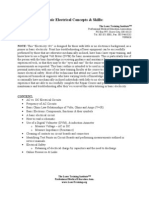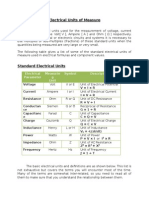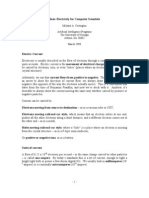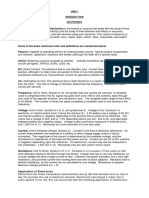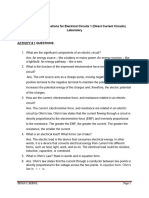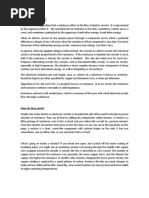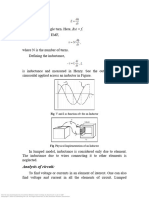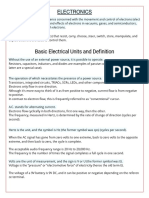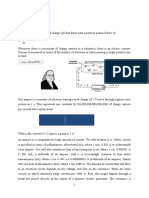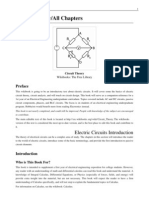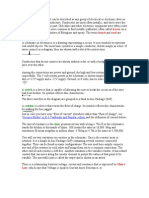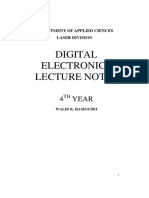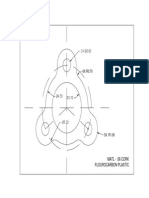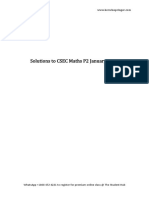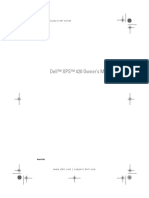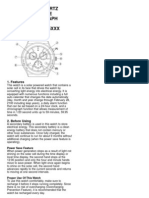All About Electronics
All About Electronics
Uploaded by
Rhea Daluddung SanchezCopyright:
Available Formats
All About Electronics
All About Electronics
Uploaded by
Rhea Daluddung SanchezOriginal Description:
Copyright
Available Formats
Share this document
Did you find this document useful?
Is this content inappropriate?
Copyright:
Available Formats
All About Electronics
All About Electronics
Uploaded by
Rhea Daluddung SanchezCopyright:
Available Formats
1.
0 Introduction to Part 1
Having looked at some of the alternative offerings on the web, I decided it was time to do a series on basic electronics.
Most I have seen are either too simplistic, and do not explain each component well enough, or are so detailed that it is
almost impossible to know what you need to know as opposed to what you are told you need. These are usually very
different.
Basic components are not always as simple as they may appear at first look. This article is intended for the beginner to
electronics, who will need to know a number of things before starting on even the simplest of projects. The more
experienced hobbyist will probably learn some new things as well, since there is a good deal of information here that
most non-professionals will be unaware of.
This is by no means an exhaustive list, and I shall attempt to keep a reasonable balance between full explanations and
simplicity. I shall also introduce some new terminology as I go along, and it is important to read this the way it was
written, or you will miss the explanation of each term as it is first encountered.
It must be noted that the US still retains some very antiquated terminology, and this often causes great confusion for the
beginner (and sometimes the not-so-beginner as well). You will see some "beat-ups" of the US - citizens of same,
please don't be offended, but rather complain bitterly to anyone you see using the old terminology.
Within The Audio Pages, I use predominantly European symbols and terminology - these are also the recommended
(but not mandatory) symbols and terms for Australia, and I have been using them for so long that I won't be changing
them.
2.0 Definitions
The basic electrical units and definitions are as shown below. This list is not exhaustive (also see the Glossary), but
covers the terms you will encounter most of the time. Many of the terms are somewhat inter-related, so you need to
read all of them to make sure that you understand the relationship between them.
Passive: Capable of operating without an external power source.
Typical passive components are resistors, capacitors, inductors and diodes (although the latter are a
special case).
Active: Requiring a source of power to operate.
Includes transistors (all types), integrated circuits (all types), TRIACs, SCRs, LEDs, etc.
DC: Direct Current
The electrons flow in one direction only. Current flow is from negative to positive, although it is often
more convenient to think of it as from positive to negative. This is sometimes referred to as
"conventional" current as opposed to electron flow.
AC: Alternating Current
The electrons flow in both directions in a cyclic manner - first one way, then the other. The rate of
change of direction determines the frequency, measured in Hertz (cycles per second).
Frequency: Unit is Hertz, Symbol is Hz, old symbol was cps (cycles per second)
A complete cycle is completed when the AC signal has gone from zero volts to one extreme, back
through zero volts to the opposite extreme, and returned to zero. The accepted audio range is from
20Hz to 20,000Hz. The number of times the signal completes a complete cycle in one second is the
frequency.
Voltage: Unit is Volts, Symbol is V or U, old symbol was E
Voltage is the "pressure" of electricity, or "electromotive force" (hence the old term E). A 9V battery has
a voltage of 9V DC, and may be positive or negative depending on the terminal that is used as the
reference. The mains has a voltage of 220, 240 or 110V depending where you live - this is AC, and
alternates between positive and negative values. Voltage is also commonly measured in millivolts (mV),
and 1,000 mV is 1V. Microvolts (uV) and nanovolts (nV) are also used.
Current: Unit is Amperes (Amps), Symbol is I
Current is the flow of electricity (electrons). No current flows between the terminals of a battery or other
voltage supply unless a load is connected. The magnitude of the current is determined by the available
voltage, and the resistance (or impedance) of the load and the power source. Current can be AC or DC,
positive or negative, depending upon the reference. For electronics, current may also be measured in
mA (milliamps) - 1,000 mA is 1A. Nanoamps (nA) are also used in some cases.
Resistance: Unit is Ohms, Symbol is R or
Resistance is a measure of how easily (or with what difficulty) electrons will flow through the device.
Copper wire has a very low resistance, so a small voltage will allow a large current to flow. Likewise, the
plastic insulation has a very high resistance, and prevents current from flowing from one wire to those
adjacent. Resistors have a defined resistance, so the current can be calculated for any voltage.
Resistance in passive devices is always positive (i.e. > 0)
Capacitance: Unit is Farads, Symbol is C
Capacitance is a measure of stored charge. Unlike a battery, a capacitor stores a charge
electrostatically rather than chemically, and reacts much faster. A capacitor passes AC, but will not pass
DC (at least for all practical purposes). The reactance or AC resistance (called impedance) of a
capacitor depends on its value and the frequency of the AC signal. Capacitance is always a positive
value.
Inductance: Unit is Henrys, Symbol is H or L (depending on context)
Inductance occurs in any piece of conducting material, but is wound into a coil to be useful. An inductor
stores a charge magnetically, and presents a low impedance to DC (theoretically zero), and a higher
impedance to AC dependent on the value of inductance and the frequency. In this respect it is the
electrical opposite of a capacitor. Inductance is always a positive value. The symbol "Hy" is sometimes
used in (guess where :-) ... the US. There is no such symbol.
Impedance: Unit is Ohms, Symbol is or Z
Unlike resistance, impedance is a frequency dependent value, and is specified for AC signals.
Impedance is made up of a combination of resistance, capacitance, and/ or inductance. In many cases,
impedance and resistance are the same (a resistor for example). Impedance is most commonly positive
(like resistance), but can be negative with some components or circuit arrangements.
Decibels: Unit is Bel, but because this is large, deci-Bels (1/10th Bel) are used), Symbol is dB
Decibels are used in audio because they are a logarithmic measure of voltage, current or power, and
correspond well to the response of the ear. A 3dB change is half or double the power (0.707 or 1.414
times voltage or current respectively). Decibels will be discussed more thoroughly in a separate section.
A few basic rules that electrical circuits always follow are useful before we start.
A voltage of 1V across a resistance of 1 Ohm will cause a current flow of 1 Amp, and the resistor will dissipate 1
Watt (all as heat).
The current entering any passive circuit equals the current leaving it, regardless of the component configuration.
Electricity can kill you!
The danger of electricity is current flowing through your body, not what is available from the source. A million
volts at 1 microamp will make you jump, but 50V at 50mA can stop you dead - literally.
An electric current flowing in a circuit does not cause vibrations at the physical level (good or bad), unless the
circuit is a vibrator, loudspeaker, motor or some other electro-mechanical device. (i.e. components don't vibrate
of their own accord unless designed to do so.)
External vibrations do not affect the operation of 99.9% of electronic circuits, unless of a significant magnitude to
cause physical damage, or the equipment is designed to detect such vibrations (for example, a microphone).
Power is measured in Watts, and PMPO does not exist except in the minds of advertising writers.
Large capacitors are not intrinsically "slower" than small ones (of the same type). Large values take longer to
charge and discharge, but will pass AC just as well as small ones. They are better for low frequencies.
Electricity can still kill you, even after reading this article.
Some of these are intended to forewarn you against some of the outrageous claims you will find as you research these
topics further, and others are simple electrical rules that apply whether we like it or not.
3.0 Wiring Symbols
There are many different representations for basic wiring symbols, and these are the most common. Other symbols will
be introduced as we progress.
Some Wiring Symbols
The conventions I use for wires crossing and joining are marked with a star (*) - the others are a small sample of those
in common use, but are fairly representative. Many can be worked out from their position in the circuit diagram
(schematic).
4.0 Units
The commonly accepted units in electronics are metric. In accordance with the SI (System Internationale) metric
specifications, any basic unit (such as an Ohm or Farad) will be graded or sub-graded in units of 1,000 - this gives the
following table.
Term Abbreviation Value (Scientific) Value (Normal)
Tera T 1 x 10
12
1,000,000,000,000
Giga G 1 x 10
9
1,000,000,000
Mega M 1 x 10
6
1,000,000
kilo k (lower case) 1 x 10
3
1,000
Units - 1 1
Milli m 1 x 10
-3
1 / 1,000
Micro or u 1 x 10
-6
1 / 1,000,000
Nano n 1 x 10
-9
1 / 1,000,000,000
Pico p 1 x 10
-12
1 / 1,000,000,000,000
Metric Multiplication Units
The abbreviations and case are important - "m" is quite clearly different from "M". In general, values smaller than unity
use lower case, and those greater than unity use upper case. "k" is clearly an exception to this. There are others that
go above and below those shown, but it is unlikely you will encounter them. Even Giga and Tera are unusual in
electronics (except for determining the size hard drive needed to install a Microsoft application :-)
5.0 Resistors
The first and most common electronic component is the resistor. There is virtually no working circuit I know of that
doesn't use them, and a small number of practical circuits can be built using nothing else. There are three main
parameters for resistors, but only two of them are normally needed, especially for solid state electronics.
Resistance - the value of resistance, measured in Ohms. This is the primary parameter, and determines the
current flow for any applied voltage.
Power - The amount of power the resistor can handle safely. Large resistors (physically) generally have a
higher power rating than small ones, and this is always specified by the manufacturer. Excess power will cause
the resistor to overheat and fail, often in a spectacular manner.
Voltage - Rarely specified, but this is the maximum voltage that may appear across a resistor. It has nothing to
do with power rating, which may be exceeded at rated voltage. It is a measure of the maximum voltage that
may appear across any value of resistance for this style without breakdown.
The resistance value is specified in ohms, the standard symbol is "R" or . Resistor values are often stated as "k" (kilo,
or times 1,000) or "M", (meg, or times 1,000,000) for convenience. There are a few conventions that are followed, and
these can cause problems for the beginner. To explain - a resistor has a value of 2,200 Ohms. This may be shown as
any of these ...
2,200 Ohms
2,200
2,200R
2.2k
2.2k
2k2
The use of the symbol for Ohms (Omega, is optional, and is most commonly left off, since it is irksome to add from
most keyboards. The letter "R" and the "2k2" conventions are European, and not commonly seen in the US and other
backward countries :-) Other variants are 0R1, for example, which means 0.1 Ohm
The schematic symbols for resistors are either of those shown below. I use the Euro version of the symbol exclusively.
Figure 1.1 - Resistor Symbols
The basic formula for resistance is Ohm's law, which states that ...
1.1.1 R = V / I Where V is voltage, I is current, and R is resistance
The other formula you need with resistance is Power (P)
1.1.2 P = V
2
/ R
1.1.3 P = I
2
* R
The easiest way to transpose any formula is what I call the "Transposition Triangle" - which can (and will) be applied to
other formulae. The resistance and power forms are shown below - just cover the value you want, and the correct
formula is shown. In case anyone ever wondered why they had to do algebra at school, now you know - it is primarily
for the manipulation of a formula - they just don't teach the simple ways. A blank between two values means they are
multiplied, and the line means divide.
Figure 1.2 - Transposition Triangles for Resistance
Needless to say, if the value you want is squared, then you need to take the square root to get the actual value. For
example, you have a 100 Ohm, 5W resistor, and want to know the maximum voltage that can be applied. V
2
= P * R =
500, and the square root of 500 is 22.36, or 22V. This is the maximum voltage across the resistor to remain within its
power rating.
Resistors have the same value for AC and DC - they are not frequency dependent within the normal audio range. Even
at radio frequencies, they will tend to provide the same value, but at very high frequencies other effects become
influential. These characteristics will not be covered, as they are outside the scope of this article.
A useful thing to remember for a quick calculation is that 1V across a 1k resistor will have 1mA of current flow - therefore
10V across 1k will be 10mA (etc.).
5.1 Standard Values
There are a number of different standards, commonly known as E12, E24, E48 and E96, meaning that there are 12, 24,
48 or 96 individual values per decade (e.g. from 1k to 10k). The most common, and quite adequate for 99.9% of all
projects, are the E12 and E24 series, and I shall not bother with the others at this time. The E12 and E24 series follow
these sequences:
1
1.2
1.5
1.8
2.2
2.7
3.3
3.9
4.7
5.6
6.8
8.2
10
Table 1.2 - E12 Resistor Series
1
1.2
1.5
1.8
2.2
2.7
3.3
3.9
4.7
5.6
6.8
8.2
10
1.1
1.3
1.6
2.0
2.4
3.0
3.6
4.3
5.1
6.2
7.5
9.1
Table 1.3 - E24 Resistor Series
Generally, 5% resistors will follow the E12 sequence, and 1% or 2% resistors will be available in the E24 sequence.
Wherever possible in my projects, I use E12 as these are commonly available almost everywhere.
Resistors are commonly available in values ranging from 0.1 Ohm (0R1) up to 10M Ohms (10,000,000 Ohms). Not all
values are available in all types, and close tolerances are uncommon in very high and very low values.
5.2 Colour Codes
Low power (<= 2W) resistors are nearly always marked using the standard colour code. This comes in two variants - 4
band and 5 band. The 4 band code is most common with 5% and 10% tolerance, and the 5 band code is used with 1%
and better.
Colour First Digit Second Digit Third Digit Multiplier Tolerance
Black 0 0 0 1
Brown 1 1 1 10 1%
Red 2 2 2 100 2%
Orange 3 3 3 1,000
Yellow 4 4 4 10,000
Green 5 5 5 100,000
Blue 6 6 6 1,000,000
Violet 7 7 7
Grey 8 8 8
White 9 9 9
Gold
0.1 5%
Silver
0.01 10%
Table 1.1 - Resistor Colour Code
My apologies if the colours look wrong - blame the originators of the HTML colours, which are a little restricting, to say
the least. With the 4 band code, the third digit column is not used, it is only used with the 5 band code. This is
somewhat confusing, but we are unable to change it, so get used to it. Personally, I suggest the use of a multimeter
when sorting resistors - I know it's cheating, but at least you don't get caught out by incorrectly marked components (and
yes, this does happen).
5.3 Tolerance
The tolerance of resistors is mostly 1%, 2%, 5% and 10%. In the old days, 20% was also common, but these are now
rare. Even 10% resistors are hard to get except in extremely high or low values (> 1M or < 1R), where they may be the
only options available at a sensible price.
A 100R resistor with 5% tolerance may be anywhere between 95 and 105 ohms - in most circuits this is insignificant, but
there will be occasions where very close tolerance is needed (e.g. 0.1% or better). This is fairly rare for audio, but there
are a few instances where you may see such close tolerance components.
5.4 Power Ratings
Resistors are available with power ratings of 1/8th W (or less for surface mount devices), up to hundreds of watts. The
most common are 1/4W (0.25W), 1/2W (0.5W), 1W, 5W and 10W. Very few projects require higher powers, and it is
often much cheaper to use multiple 10W resistors than a single (say) 50W unit. They will also be very much easier to
obtain.
Like all components, it is preferable to keep temperatures as low as possible, so no resistor should be operated at its full
power rating for any extended time. I recommend a maximum of 0.5 of the power rating wherever possible. Wirewound
resistors can tolerate severe overloads for a short period, but I prefer to keep the absolute maximum to somewhat less
than 250% - even for very brief periods, since they may become open circuit from the stress, rather than temperature
(this does happen, and I have experienced it during tests and repairs).
5.5 Resistance Materials
Resistors are made from a number of different materials. I shall only concentrate on the most common varieties, and
the attributes I have described for each are typical - there will be variations from different makers, and specialised types
that don't follow these (very) basic characteristics. All resistors are comparatively cheap.
Carbon Composition: Low to medium power. Comparatively poor tolerance and stability. Noisier than most
others.
Carbon Film: Low power. Reasonable tolerance and stability. Reasonably quiet.
Metal Film: Low to medium power. Very good tolerance and stability. Quiet.
Wirewound: High to very high power. Acceptable to very good tolerance, good stability. Quiet. May have
inductance.
A couple of points to ponder. Resistors make noise! Everything that is above 0K (zero Kelvin, absolute zero, or -273
degrees Celsius) makes noise, and resistors are no exception. Noise is proportional to temperature and voltage. Low
noise circuits will always use low resistor values and low voltage wherever possible.
Resistors may also have inductance, and wirewound types are the worst for this. There are non-inductive wirewound
resistors, but are not readily available, and usually not cheap.
6.0 Capacitors
Capacitors come in a bewildering variety of different types. The specific type may be critical in some applications, where
in others, you can use anything you please. Capacitors are the second most common passive component, and there
are few circuits that do not use at least one capacitor.
A capacitor is essentially two conductive plates, separated by an insulator (the dielectric). To conserve space, the
assembly is commonly rolled up, or consists of many small plates in parallel for each terminal, each separated from the
other by a thin plastic film. See below for more detailed information on the different constructional methods. A capacitor
also exists whenever there is more than zero components in a circuit - any two pieces of wire will have some degree of
capacitance between them, as will tracks on a PCB, and adjacent components. Capacitance also exists in
semiconductors (diodes, transistors), and is an inescapable part of electronics.
There are two main symbols for capacitors, and one other that is common in the US, but rarely seen elsewhere. Caps
(as they are commonly called) come in two primary versions - polarised and non-polarised. Polarised capacitors must
have DC present at all times, of the correct polarity and exceeding any AC that may be present on the DC polarising
voltage. Reverse connection will result in the device failing, often in a spectacular fashion, and sometimes with the
added excitement of flames, or high speed pieces of casing and electrolyte (an internal fluid in many polarised caps).
This is not a good thing.
Figure 6.1 - Capacitor Symbols
Capacitors are rated in Farads, and the standard symbol is "C" or "F", depending upon the context. A Farad is so big
that capacitors are most commonly rated in micro-Farads (uF). The Greek letter (lower case) Mu is the proper symbol,
but "u" is available on keyboards, and is far more common. Because of the nature of capacitors, they are also rated in
very much smaller units than the micro-Farad - the units used are ...
mF: Milli-Farad, 1x10
-3
Farad (1,000th of a Farad) - uncommon
uF: Micro-Farad, 1x10
-6
Farad (1,000,000th of a Farad)
mF: Micro-Farad, a very, very old term, still sometimes used in the US (True!) - Causes much confusion.
ufd: Micro-Farad, another very old term, still used in the US
mfd (or MFD): Yet another antiquated term - US again!
nF: Nano-Farad, 1x10
-9
Farad (1,000,000,000th of a Farad) - Common everywhere except the US
pF: Pico-Farad, 1x10
-12
Farad (1,000,000,000,000th of a Farad)
mmF: Micro-Micro-Farad, another extremely old term, also still used sometimes in the US
The items in bold are the ones I use in all articles and projects, and the others should be considered obsolete and not
used - at all, by anyone !
Milli-Farads (mF) should be used for large values, but are generally avoided because of the US's continued use of the
ancient terminology. When I say ancient, I mean it - these terms date back to the late 1920s or so. Any time you see
the term "mF", it almost certainly means uF - especially if the source is the US. You may need to determine the correct
value from its usage in the circuit.
A capacitor with a value of 100nF may also be written as 0.1uF (especially in the US). A capacitor marked on a
schematic as 2n2 has a value of 2.2nF, or 0.0022uF (mF ??). It may also be written (or marked) as 2,200pF. These are
all equivalent, and although this may appear confusing (it is), it is important to understand the different terms that are
applied.
A capacitor has an infinite (theoretically!) resistance at DC, and with AC, it has an impedance. Impedance is defined as
a non-resistive (or only partially resistive) load, and is frequency dependent. This is a very useful characteristic, and is
used to advantage in many circuits.
In the case of a capacitor, the impedance is called Capacitive Reactance generally shown as Xc. The formula for
calculating Xc is shown below ...
6.1.1 Xc = 1 / 2 F C where is 3.14159..., F is frequency in Hertz, and C is capacitance in Farads
The Transposition Triangle can be used here as well, and simplifies the extraction of the wanted value considerably.
Figure 6.2 - Capacitance Triangle
As an example, what is the formula for finding the frequency where a 10uF capacitor has a reactance of 8 Ohms?
Simply cover the term "F" (frequency), and the formula is
6.1.2 F = 1 / 2 C Xc
In case you were wondering, the frequency is 1.989kHz (2kHz near enough). At this frequency, if the capacitor were
feeding an 8 ohm loudspeaker, the frequency response will be 3dB down at 2kHz, and the signal going to the speaker
will increase with increasing frequency. Since the values are the same (8 ohm speaker and 8 ohms reactance) you
would expect that the signal should be 6dB down, but because of phase shift (more on this later), it is actually 3dB.
With capacitors, there is no power rating. A capacitor in theory dissipates no power, regardless of the voltage across it
or the current through it. In reality, this is not quite true, but for all practical purposes it does apply.
All capacitors have a voltage rating, and this must not be exceeded. If a higher than rated voltage is applied, the
insulation between the "plates" of the capacitor breaks down, and an arc will often weld the plates together, short
circuiting the component. The "working voltage" is DC unless otherwise specified, and application of an equivalent AC
signal will probably destroy the capacitor.
6.1 Standard Values
Capacitors generally follow the E12 sequence, but with some types, there are very few values available within the
range. There are also a few oddities, especially with electrolytic caps (these are polarised types).
1
1.2
1.5
1.8
2.2
2.7
3.3
3.9
4.7
5.6
6.8
8.2
10
Table 6.1 - E12 Capacitor Series
Some electrolytic types have non-standard values, such as 4,000uF for example. These are easily recognised, and
should cause no fear or panic :-)
6.2 Capacitor Markings
Unlike resistors, few capacitors are colour coded. Some years ago, various European makers used colour codes, but
these have gone by the wayside for nearly all components available today. This is not to say that you won't find them,
but I am not going to cover this.
The type of marking depends on the type of capacitor in some cases, and there are several different standards in
common use. Because of this, each type shall be covered separately.
Ceramic: These caps are usually used when extremely low values are needed. Ceramic caps typically range in
value from 1pF up to 100nF, but in some cases and styles this will vary. They are commonly marked in pF
(such as 100p), or a multiplier is used (such as 101, meaning 100pF - 10 plus one zero).
Plastic Film: These are available in many different materials. Polyester is one of the most popular capacitor
types, and these combine predictable size (especially the MKT types) and good performance. MKT caps use
various different markings, and it takes some familiarity before you will feel completely comfortable. We will use
a 47nF (0.047uF) MKT cap as an example. This could be marked as 473k, 473k63, or 47n. A 4.7nF cap may
be marked 472k, 472k63, or 4n7. The third digit is a multiplier, and indicates the number of zeros to give the
value in pF. 63 means that the working voltage is 63V, and this must not be exceeded.
Electrolytic: Used where large values are needed, these caps are (nearly) always marked directly with the
value in uF and the maximum voltage. Sometimes the maximum temperature is also indicated, but if not, 85
deg C should be assumed. Electros are polarised, and the negative terminal is marked clearly on the case. For
"RB" style caps (printed circuit board mounting), the positive lead is usually the longer of the two.
Tantalum: Another form of polarised capacitor. Theoretically unaffected by zero bias voltage, I (and many
others) have found them to be unreliable regardless of usage. Some tantalum caps are colour coded - I do not
propose to discuss these any further, so if you use them, you will have to figure out the markings for yourself.
6.3 Tolerance
The quoted tolerance of most polyester (or other plastic film types) capacitors is typically 10%, but in practice it is usually
better than that. Close tolerance types (e.g. 1%) are available, but they are usually rather expensive. If you have a
capacitance meter, it is far cheaper to buy more than you need, and select them yourself.
Electrolytic capacitors have a typical tolerance of +50/-20%, but this varies from one manufacturer to the next.
Electrolytics are also affected by age, and as they get older, the capacitance falls. Modern electros are better than the
old ones, but they are still potentially unreliable at elevated temperatures or with significant current flow (AC, of course).
6.4 Capacitance Materials
As you have no doubt discovered by now, the range is awesome. Although some of the types listed below are not
especially common, these are the most popular of the capacitors available. There is a school of thought that the
differences between various dielectrics are audible, and although this may be true in extreme cases, generally I do not
believe this to be the case - provided of course that a reasonable comparison is made, using capacitors designed for the
application.
Many of the capacitors listed are "metallised", meaning that instead of using aluminium or other metal plates, the film is
coated with an extremely thin layer of vapourised metal. This makes the capacitor much smaller than would otherwise
be the case.
Silvered Mica: Probably the most linear low value capacitor, these are most commonly used in RF applications
where the dielectric losses would preclude other types. They are physically large and comparatively expensive.
Polystyrene: Very good electrical properties, including exceptionally high dielectric resistance. Very linear and
stable, but physically large. Polystyrene is affected by many solvents, and is unsuitable for high temperatures.
Ceramic: Excellent high frequency performance, but not stable with temperature (except NPO types). The
temperature sensitivity is often used to stabilise RF oscillators. Very good bypass caps for high speed opamps.
Not recommended for use in the audio path. Commonly available in voltages up to 3kV or more.
Monolithic Ceramic: Designed as bypass capacitors, these are physically small, and have excellent HF
performance. Stability is suspect, and they are not recommended for use in the audio path.
Polyester: One of the most popular types, in the "MKT" package style. Stable and reliable, but generally only
low voltage (up to 100V). Suitable for all audio applications, as well as bypass on power amplifiers and opamps.
Mylar: Also known as "Greencaps" - another popular cap, suitable for all audio applications, as well as bypass
for power amps and opamps. (Note that Greencaps may also be polyester).
Polypropylene: Available in relatively large values, and excellent for passive loudspeaker crossover networks.
Said by some to be audibly superior to other plastic film types (personally, I doubt this claim).
PET: (Polyethylene Terephthalate) - the same stuff that plastic drink bottles are made from. Used in many
different types of plastic film caps, often replacing polyester or mylar
Electrolytic: Using plates of aluminium and an electrolyte to provide conductivity, these caps use an extremely
thin layer of aluminium oxide (created by anodising) as the dielectric. This gives very high capacitance per unit
volume, and electros are used as coupling capacitors, filter capacitors in power supplies, and anywhere where a
close tolerance is not needed, but high capacitance is necessary. They have a maximum current rating which
must not be exceeded, and are somewhat unreliable. There are no alternatives.
Low Leakage Electrolytic: These are a "premium" version of standard electrolytic capacitors, and are used
where relatively high capacitance is required, but leakage (DC current flow) is undesirable, even at very low
values. These are (IMHO) a better alternative than ...
Tantalum: Very high capacitance per unit volume, but probably the most unreliable capacitor ever made. I do
not recommend their use unless there is no alternative (this is rare).
Bipolar Electrolytic: Two polarised electrolytic capacitors in series, with the positive (or negative) terminals
joined internally. These are often used in crossover networks, and offer low cost and small size. They are not
especially reliable at any appreciable power, and I don't recommend them. They are sometimes useful in
circuits where a high value cap is needed, but there is little or no polarising voltage. I have found no problems
with them in this application, but distortion may be an issue in some cases.
Oil/ Paper: These were used many years ago, and can still be found as motor start and power factor factor
correction capacitors. They are extremely rugged, and are self-healing. They do not fail as a short circuit - any
arc is extinguished by the oil, and the cap can continue to function normally after the excess voltage is removed.
This is only a basic listing, but gives the reader an idea of the variety available. The recommendations are mine, but
there are many others in the electronics industry who will agree with me (as well as many who will not - such is life).
Apart from the desired quantity of capacitance, capacitors have some unwanted features as well. Many of them -
especially electrolytics - have significant inductance, and they all posses some value of resistance (although generally
small). The resistance is referred to as ESR (Equivalent Series Resistance), and this can have adverse effects at high
currents (e.g. power supplies). Although it exists in all capacitors, ESR is generally quoted only for electrolytics.
7.0 Inductors
These are the last of the purely passive components. An inductor is most commonly a coil, but in reality, even a straight
piece of wire has inductance. Winding it into a coil simply concentrates the magnetic field, and increases the inductance
considerably for a given length of wire. Although there are some very common inductive components (such as
transformers, which are a special case), they are not often used in audio. Small inductors are sometimes used in the
output of power amplifiers to prevent instability with capacitive loads.
Note: Transformers are a special case of inductive components, and will be covered separately.
Even very short component leads have some inductance, and like capacitance, it is just a part of life. Mostly in audio,
these stray inductances cause no problems, but they can make or break a radio frequency circuit, especially at the
higher frequencies.
An inductor can be considered the opposite of a capacitor. It passes DC with little resistance, but becomes more of an
obstacle to the signal as frequency increases.
There are a number of different symbols for inductors, and three of them are shown below. Somewhat perversely
perhaps, I use the "standard" symbol most of the time, since this is what is supported best by my schematic drawing
package.
Figure 7.1 - Inductor Symbols
There are other core types not shown above. Dotted lines instead of solid mean that the core is ferrite or powdered iron,
rather than steel laminations or a toroidal steel core. Note that pure iron is rarely (if ever) used, since there are various
grades of steel with much better magnetic properties. The use of a magnetic core further concentrates the magnetic
field, and increases inductance, but at the expense of linearity. Steel or ferrite cores should never be used in crossover
networks for this reason (although many manufacturers do just that, and use bipolar electrolytic capacitors to save
costs).
Inductance is measured in Henrys (H) and has the symbol "L" (yes, but ... Just accept it :-). The typical range is from a
few micro-Henrys up to 10H or more. Although inductors are available as components, there are few (if any)
conventions as to values or markings. Some of the available types may follow the E12 range, but then again they may
not.
Like a capacitor, an inductor has reactance as well, but it works in the opposite direction. The formula for calculating the
inductive reactance (X
L
) is ...
7.1.1 X
L
= 2 F L where L is inductance in Henrys
As before, the transposition triangle helps us to realise the wanted value without having to remember basic algebra.
Figure 7.2 - Inductance Triangle
An inductor has a reactance of 8 ohms at 2Khz. What is the inductance? As before, cover the wanted value, in this
case inductance. The formula becomes ...
7.1.2 L = X
L
/ 2 F
The answer is 636uH. From this we could deduce that a 636uH inductor in series with an 8 ohm loudspeaker will
reduce the level by 3dB at 2kHz. Like the capacitor, when inductive reactance equals resistance, the response is 3dB
down, and not 6dB as would be the case with two equal resistances. What we have done in these last two examples is
design a simple 2kHz passive crossover network, using a 10uF capacitor to feed the tweeter, and a 636uH inductor
feeding the low frequency driver.
Like a capacitor, an inductor (in theory) dissipates no power, regardless of the voltage across it or the current passing
through. In reality, all inductors have resistance, so there is a finite limit to the current before the wire gets so hot that
the insulation melts.
7.1 Quality Factor
The resistance of a coil determines its Q, or Quality factor. An inductor with high resistance has a low Q, and vice
versa. I do not propose to cover this in any more detail at this stage, and most commercially available inductors will
have a sufficiently high Q for anything we will need in audio. If desired, the Q of any inductor may be reduced by wiring
a resistor in series with the coil, but it cannot be increased because of its internal limitations.
7.2 Power Ratings
Because of the resistance, there is also a limit to the power that any given inductor can handle. In the case of any
inductor with a magnetic core, a further (and usually overriding) limitation is the maximum magnetic flux density
supported by the magnetic material before it saturates. Once saturated, any increase in current causes no additional
magnetic field (since the core cannot support any more magnetism), and the inductance falls. This causes gross non-
linearities, which can have severe repercussions in some circuits (such as a switchmode power supply).
7.3 Inductance Materials
The most common winding material is copper, and this may be supported on a plastic bobbin, or can be self-supporting
with the aid of cable ties, lacquer, or epoxy potting compounds. Iron or ferrite cores may be toroidal (shaped like a ring),
or can be in the traditional EI (ee-eye) format. In some cases for crossover networks and some other applications, a
piece of magnetic material is inserted through the middle of the coil, but does not make a complete magnetic circuit.
This reduces inductance compared to a full core, but reduces the effects of saturation, and allows much higher power
ratings.
7.4 Core Types
Inductors may use a variety of materials for the core, ranging from air (lowest inductance, but highest linearity), through
to various grades of steel or ferrite materials. Since inductors are nearly always used only for AC operation, the
constantly changing magnetic flux will induce a current into any conductive core material in a similar manner to a
transformer. This is called "eddy current" and represents a total loss in the circuit. Because the currents may be very
high, this leads to the core becoming hot, and also reduces performance.
To combat this, steel cores are laminated, using thin sheets of steel insulated from each other. This prevents the
circulating currents from becoming excessive, thereby reducing losses considerably. As the frequency increases, even
the thin sheets will start to suffer from losses, so powdered iron (a misnomer, since it is more commonly powdered steel)
cores are used. Small granules of magnetic material are mixed with a suitable bonding agent, and fired at high
temperature to form a ceramic-like material that has excellent magnetic properties. The smaller the magnetic particles
(and the less bonding agent used), the better the performance at high power and high frequencies. It is important that
the individual granules are insulated from each other, or losses will increase.
These materials are available in a huge variety of different formulations, and are usually optimised for a particular
operating frequency range. Some are designed for 20kHz up to 200kHz or so, and these are commonly used for
switchmode power supplies, television "flyback" transformers and the like. Other materials are designed to operate at
radio frequencies (RF), and these are most commonly classified as "ferrite" cores. In some cases, the terms "powdered
iron" and "ferrite" are used interchangeably, but this is not correct - they are different materials with different properties.
These will be covered in more detail when transformers are discussed.
8.0 Components in Combination
Components in combination form most of the circuits we see. All passives can be arranged in series, parallel, and in
any number of different ways to achieve the desired result. Amplification is not possible with passive components, since
there is no means to do so. This does not mean that we are limited - there are still many combinations that are
extremely useful, and they are often used around active devices (such as opamps) to provide the characteristics we
need. Parallel operation is often used to obtain greater power, where a number of low power resistors are wired in
parallel to get a lower resistance, but higher power. Series connections are sometimes used to obtain very high values
(or to increase the voltage rating). There are endless possibilities, and I shall only concentrate on the most common.
8.1 Resistors
Resistors can be wired in parallel or in series, or any combination thereof, so that values greater or smaller than normal
or with higher power or voltage can be obtained. This also allows us to create new values, not catered for in the
standard values.
Figure 8.1 - Some Resistor Combinations
Series: When wired in series, the values simply add together. A 100 ohm and a 2k2 resistor in series will have a value
of 2k3.
8.1.1 R = R1 + R2 (+ R3, etc.)
Parallel: In parallel, the value is lower than either of the resistors. A formula is needed to calculate the final value
8.1.2 1/R = 1/R1 + 1/R2 (+ 1/R3 etc.) Also written as ...
8.1.3 R = 1 / ((1 / R1) + (1 / R2)) An alternative for two resistors is ...
8.1.4 R = (R1 * R2) / (R1 + R2)
The same resistors as before in parallel will have a total resistance of 95.65 ohms (100 || 2,200). Either formula above
may be used for the same result.
Four 100 ohm 10W resistors gives a final value of either 400 ohms 40W (series), 25 ohms 40W (parallel) or 100 ohms
50W (series/ parallel).
Voltage Dividers: One of the most useful and common applications for resistors. A voltage divider is used to reduce
the voltage to something more suited to our needs. This connection provides no "transformation", but is used to match
impedances or levels. The formula for a voltage divider is
8.1.5 Vd = (R1 + R2) / R2
With our standard resistors as used above, we can create a voltage divider of 23 (R1=2k2, R2=100R) or 1.045
(R1=100R, R2=2k2). Perhaps surprisingly, both of these are useful !
8.2 Capacitors
Like resistors, capacitors can also be wired in series, parallel or a combination.
Figure 8.2 - Capacitor Combinations
The capacitive voltage divider may come as a surprise, but it is a useful circuit, and is common in RF oscillators and
precision attenuators (the latter in conjunction with resistors). Despite what you may intuitively think, the capacitive
divider is not frequency dependent, so long as the source impedance is low, and the load impedance is high compared
to the capacitive reactance.
When using caps in series or parallel, exactly the opposite formulae are used from those for resistance. Caps in parallel
have a value that is the sum of the individual capacitances. Here are the calculations ...
Parallel: A 12nF and a 100nF cap are wired in parallel. The total capacitance is 112nF
8.2.1 C = C1 + R2 (+ R3, etc.)
Series: In series, the value is lower than either of the caps. A formula is needed to calculate the final value
8.2.2 1 / C = 1 / C1 + 1 / C2 (+ 1 / C3 etc.) Also written as ...
8.2.3 C = 1 / ((1 / C1) + (1 / C2)) An alternative for two capacitors is ...
8.2.4 C = (C1 * C2) / (C1 + C2)
This should look fairly familiar by now. The same two caps in series will give a total value of 10n7 (10.7nF).
The voltage divider is calculated in the same way, except that the terms are reversed (the larger capacitor has a lower
reactance).
8.3 Inductors
I shall leave it to the reader to determine the formulae, but suffice to say that they behave in the same way as resistors
in series and parallel. The formulae are the same, except that "L" (for inductance) is substituted for "R".
An inductive voltage divider can also be made, but it is much more common to use a single winding, and connect a
tapping to it for the output. This allows the windings to share a common magnetic field, and makes a thoroughly useful
component. These inductors are called "autotransformers", and they behave very similarly to a conventional
transformer, except that only one winding is used, so there is no isolation. As a suitable introduction to the transformer, I
have shown the circuit for a variable voltage transformer, called a Variac (this is trademarked, but the term has become
generic for such devices).
Figure 8.3 - The Schematic of a Variac
A Variac is nothing more than an iron cored inductor. The mains is applied to a tap about 10% from the end of the
winding. The sliding contact allows the output voltage to be varied from 0V AC, up to about 260V (for a 240V version).
As a testbench tool they are indispensable, and they make a fine example of a tapped inductance as well.
I stated before that passive components cannot amplify, yet I have said here that 240V input can become 260V output.
Surely this is amplification? No, it is not. This process is "transformation", and is quite different. The term "amplifier"
indicates that there will be a power gain in the circuit (as well as voltage gain in most amps), and this cannot be
achieved with a transformer. Even assuming an "ideal" component (i.e. one having no losses), the output power can
never exceed the input power, so no amplification has taken place.
9.0 Composite Circuits
When any or all of the above passive components are combined, we create real circuits that can perform functions that
are not possible with a single component type. These "composite" circuits make up the vast majority of all electronics
circuits in real life, and understanding how they fit together is very important to your understanding of electronics.
The response of various filters is critical to understanding the way many electronics circuits work. Figure 5.0 shows the
two most common, and two others will be introduced as we progress further.
Figure 9.1 - High Pass and Low Pass Filter Response
The theoretical response is shown, and the actual response is in grey. Real circuits (almost) never have sharp
transitions, and the curves shown are typical of most filters. The most common use of combined resistance and
reactance (from a capacitor or inductor) is for filters. Fo is the frequency at which response is 3dB down in all such
filters.
Within this article, only single pole (also known as 1st order) filters will be covered - the idea is to learn the basics, and
not get bogged down in great detail with specific circuit topologies. A simple first order filter has a rolloff of 6dB per
octave, meaning that the voltage (or current) of a low pass filter is halved each time the frequency is halved. In the case
of a high pass filter, the signal is halved each time the frequency is doubled. These conditions only apply when the
applied signal is at least one octave from the filter's "corner" frequency.
This slope is also referred to as 20dB per decade, so the signal is reduced by 20dB for each decade (e.g. from 100Hz to
1kHz) from the corner frequency.
9.1 Resistance / Capacitance Circuits
When resistance (R) and capacitance (C) are used together, we can start making some useful circuits. The combination
of a non-reactive (resistor) and a reactive (capacitor) component creates a whole new set of circuits. Simple filters are
easily made, and basic circuits such as integrators (low pass filters) and differentiators (high pass filters) will be a breeze
after this section is completed.
The frequency of any filter is defined as that frequency where the signal is 3dB lower than in the pass band. A low pass
filter is any filter that passes frequencies below the "turnover" point, and the relationship between R, C and F is shown
below ...
9.1.1 F = 1 / 2 R C I shall leave it to you to fit this into the transposition triangle.
A 10k resistor and a 100nF capacitor will have a "transition" frequency (Fo) of 159Hz, and it does not matter if it is
connected as high or low pass. Sometimes, the time constant is used instead - Time Constant is defined as the time
taken for the voltage to reach 68% of the supply voltage upon application of a DC signal, or discharge to 37% of the fully
charged voltage upon removal of the DC. This depends on the circuit configuration.
9.1.2 T = R C Where T is time constant
For the same values, the time constant is 1ms (1 millisecond, or 1/1,000 second). The time constant is used mainly
where DC is applied to the circuit, and it is used as a simple timer, but is also used with AC in some instances. From
this, it is obvious that the frequency is therefore equal to
9.1.3 F = 1 / 2 T
This is not especially common, but you may need it sometime.
Figure 9.1 - Some RC Circuits
The above are only the most basic of the possibilities, and the formula (9.1.1) above covers them all. The differentiator
(or high pass filter) and integrator (low pass filter) are quite possibly the most common circuits in existence, although
most of the time you will be quite unaware that this is what you are looking at. The series and parallel circuits are shown
with one end connected to Earth - again, although this is a common arrangement, it is by no means the only way these
configurations are used. For the following, we shall assume the same resistance and capacitance as shown above -
10k and 100nF.
The parallel RC circuit will exhibit only the resistance at DC, and the impedance will fall as the frequency is increased.
At high frequency, the impedance will approach zero Ohms. At some intermediate frequency determined by formula
9.1.1, the reactance of the capacitor will be equal to the resistance, so (logically, one might think), the impedance will be
half the resistor value. In fact, this is not the case, and the impedance will be 7k07 Ohms. This needs some further
investigation ...
The series RC circuit also exhibits frequency dependent behaviour, but at DC the impedance is infinite (for practical
purposes), and at some high frequency it is approximately equal to the resistance value alone. It is the opposite of the
parallel circuit. This circuit is seen at the output of almost every solid state amplifier ever made, and is intended to
stabilise the amplifier at high frequencies in the presence of inductive loads (speaker cables and loudspeakers).
Because of a phenomenon called "phase shift" (see below) these RC circuits can only be calculated using vector
mathematics (trigonometry) or "complex" arithmetic, neither is particularly straightforward, and I will look at a simple
example only - otherwise they will not be covered here.
9.1.4 Z = (1 / (1/R
2
+ 1/Xc
2
)) For parallel circuits, or ...
9.1.5 Z = (R
2
+ Xc
2
) For series circuits.
Simple !!! Actually, it is. In the case of the series circuit, we take the square root of the two values squared - those who
still recall a little trigonometry will recognise the formula. It is a little more complex for the parallel circuit, just as it was
for parallel resistors - the only difference is the units are squared before we add them, take the square root, and the
reciprocal. If this is all too hard, there is a simple way, but it only works when the capacitive reactance equals
resistance. Since this is the -3dB frequency (upon which nearly all filters and such are specified), it will suit you most of
the time.
9.1.6 Z = 0.707 * R For parallel circuits, and ...
9.1.7 Z = 1.414 * R For series circuits.
If we work this out - having first calculated the frequency where Xc = R (159Hz), we can now apply the maths. Z is
equal to 7k07 for the parallel circuit, and 14k1 for the series circuit. Remember, this simple formula only applies when
Xc = R.
Figure 5.2 shows one of the effects of phase shift in a capacitor - the current (red trace) is out of phase with respect to
the voltage. In fact, the current is leading the voltage by 90 degrees. It may seem impossible for the current through a
device to occur before the voltage, and this situation only really applies to "steady state" signals. This is known in
electrical engineering as a leading power factor.
It becomes more complex mathematically to calculate the transient (or varying signal) behaviour of the circuit, but
interestingly, this has no effect on sound, and the performance with music will be in accordance with the steady state
calculations.
Figure 9.2 - Capacitive Phase Shift
The phase shift through any RC circuit varies with frequency, and at frequencies where Xc is low compared to the -3dB
frequency, it is minimal. Phase shift is not audible in any normal audio circuit.
When the value of the integration or differentiation capacitor is large compared to the lowest operating frequency, it is
more commonly called a coupling capacitor. The same formulae are used regardless of the nomenclature of the circuit.
9.2 Resistance / Inductance Circuits
The combination of resistance (R) and inductance (L) is much less common than RC circuits in modern electronics
circuits. Many of the same circuit arrangements can be applied, but it uncommon to do so.
These days, the most common application of RL circuits is in passive crossover networks. The speaker is not pure
resistance, but is often compensated with a "Zobel" network in an attempt to cancel the inductive component of the
speaker.
The turnover frequency (-3dB) is determined by the formula below.
9.2.1 F = R / 2 L Again, I shall leave it to you to fit this into the transposition triangle
A couple of simple RL filters are shown in Figure 9.3 for reference. These are not uncommon circuits, and they may be
seen in amplifiers and loudspeaker crossovers networks almost anywhere.
Figure 9.3 - Basic Resistance / Inductance Filters
The series circuit is typical of a simple crossover network to a woofer, and the "resistance" is the loudspeaker. The
parallel circuit is seen on the output of many amplifier circuits, and is used to isolate the amplifier from capacitive loading
effects at high frequencies. Because of the phase shift introduced by capacitance, some amplifiers become unstable at
very high frequencies, and tend to oscillate. This affects sound quality and component life (especially the transistors),
and is to be avoided.
Inductors (like capacitors) are reactive, and they cannot be calculated simply. To determine the impedance of a series
or parallel circuit requires exactly the same processes as described for capacitors. Like capacitors, inductors cause
phase shift, except the shift is the reverse - the current occurs after the voltage. In electrical engineering, this is referred
to as as a lagging power factor. This is shown in Figure 9.4, and again, the red trace is current - it can be seen that the
current occurs after the voltage.
Figure 9.4 - Inductive Phase Shift
Just as we did with capacitive reactance, if we work only with the -3dB frequency, this is where inductive reactance (X
L
)
and resistance are equal. Because the inductive reactance increases with increasing frequency (as opposed to
capacitive reactance which falls as frequency increases), the configurations for low pass and high pass are reversed.
We can still use the same simple formulae, and again, these only work when X
L
is equal to R.
9.2.2 Z = 0.707 * R For parallel circuits, and ...
9.2.3 Z = 1.414 * R For series circuits.
Integrators and differentiators can also be made using RL circuits, but they are very uncommon in normal linear
electronics circuits and will not be covered at this time.
9.3 Capacitance / Inductance Circuits
The combination of capacitance and inductance (at least in its "normal" form) is quite uncommon in audio or other low
frequency circuits. Simulated inductors (using an opamp to create an artificial component with the properties of an
inductor) are common, and they behave in a very similar manner in simple circuits.
The combination using real inductors has some fascinating properties, depending on the way they are connected.
These will be covered only briefly here - they are much more commonly used in RF work, and in some cases for
generation of very high voltages for experimental purposes (Tesla coils and car ignition coils spring to mind). A series
resonant circuit can generate voltages that are many times the input voltage, and this interesting fact can be used to
advantage (or to kill yourself!).
An inductor and capacitor in series presents a very low impedance at resonance, defined as the frequency where
inductive and capacitive reactance are equal. With ideal (i.e. completely lossless) components, the impedance at
resonance is zero, but in reality there will always be some resistance because of the resistance of the coil, and some
small capacitive losses.
Resonance (Fo) is determined by the formula ...
9.3.1 Fo = 1 / 2 L C
Yet again, the insertion of this into the transposition triangle is up to you, but you need a hint - to extract L or C, all other
terms must be squared first. (For example, 1 = 4
2
F
2
L C - the triangle is very easy now!)
Parallel resonance uses the same formula, and at resonance the impedance is theoretically infinite with ideal
components. Both of these combinations are used extensively in radio work, and parallel resonance circuits are used in
many tape machines, for example.
It is somewhat beyond the scope of this article to describe this in detail, but tape machines use a high frequency bias
oscillator to overcome the inherent distortion that occurs when a material is magnetised. The HF signal is at a very high
amplitude, because the inductance of the tape heads causes their impedance to be very high at the bias frequency
(typically between 50kHz and 150kHz). Should this high amplitude high frequency be fed into the record amplifier, the
low impedance of the amp circuit will "steal" most of the bias, and the amplifier will probably be forced into distortion as
well, and the circuit won't work. A parallel resonant circuit tuned to the bias frequency is used to isolate the bias from
the amp. It has no effect on the audio signal, because the resonance is very sharp, and it presents a low impedance
path for all signals other than the bias voltage.
A parallel or series resonant circuit can be indistinguishable from each other in some circuits, and in RF work these
resonant systems are often referred to as a "tank". Energy is stored by both reactances, and is released into a load
(such as an antenna). The energy storage allows an RF circuit to oscillate happily with only the occasional "nudge" from
a transistor or other active device - this is usually done once each complete cycle.
Figure 9.5 - Parallel and Series Resonance
I have shown the series circuit with an input and an output. If the inductance and capacitance were to be selected for
resonance at the mains frequency, and a low voltage / high current transformer were used to supply a voltage at the
input if the circuit, the voltage across the capacitor could easily reach several thousand volts. Exactly the same voltage
would appear across the inductor, but the two voltages are exactly equal and opposite, so they cancel out.
Warning
Do not attempt to build this circuit for use with mains voltages and frequency, as serious injury or death may occur. The
circuit is potentially lethal, even with an input of only a few volts. The supply current will also be extremely high, as the
series resonant circuit behaves like a short circuit at resonance. This is not in jest !
In all cases when the circuit is at resonance, the reactance of the capacitor and inductor cancel. For series resonance,
they cancel such that the circuit appears electrically as almost a short circuit. Parallel resonance is almost an open
circuit at resonance. Any "stray" impedance is pure resistance for a tank circuit at resonance.
The frequency response of an LC tuned circuit is either a frequency peak or dip as shown in Figure 5.6. Fo is now the
resonant frequency (the term seems to have come from RF circuits, where Fo means frequency of oscillation).
Figure 9.5 - Response of LC Resonant Circuits
The "Q" (or "Quality factor") of these circuits is very high, and the steep slopes leading to and from Fo are quite visible.
Ultimately, a frequency is reached where either the inductance or capacitance becomes negligible compared to the
other, and the slope becomes 6dB per octave, as with any other single pole filter. Multiple circuits can be cascaded to
improve the ultimate rolloff.
Q is defined as the frequency divided by the bandwidth, measured from the 3dB points relative to the maximum or
minimum response, F
L
and F
H
. For example, the bandpass filter shown above has a centre frequency (Fo) of 1.59kHz,
and the 3dB frequencies are 1.58kHz and 1.6kHz. 1.59kHz divided by the difference (200Hz) gives a Q of 7.95 - there
are no units for Q, it is a relative measurement only.
As a matter of interest, these figures were obtained using a 1uF capacitor, a 10mH inductor, and a 1 Ohm series
resistance. In a simulation, I used an input voltage of 1V at 1590Hz, and the voltage across L and C is 97V. This is not
amplification, since there is no power gain, but even at the low input voltage used, the circuit is potentially deadly.
Needless to say, the capacitor must be rated for the voltage, and this rating is AC - a 100V DC capacitor will fail.
A bandpass filter of this type may be used to filter a specific frequency, and effectively removes all others. This is not
strictly true of course, since the rolloff slopes are finite, but the other frequencies will be suppressed by 20dB at less than
100Hz either side of the centre frequency (74Hz on the low side and 85Hz on the high side to be exact).
Likewise, a bandstop filter will remove an offending frequency, and allows everything else through. Again, this is not as
simple as that, but the principle is sufficiently sound that these circuits are used in radio and TV receivers to extract the
wanted station and reject the others quite effectively (with some help from a lot of other circuitry as well, it must be
admitted).
You might also like
- Beginners' Guide To Electronics - Part 1: Elliott Sound ProductsDocument24 pagesBeginners' Guide To Electronics - Part 1: Elliott Sound ProductsAdbhut Charan DasNo ratings yet
- Basic Electrical Concepts & Skills:: The Laser Training Institute™Document11 pagesBasic Electrical Concepts & Skills:: The Laser Training Institute™meeravali_7No ratings yet
- Electrical Units of MeasureDocument36 pagesElectrical Units of MeasureHyung BaeNo ratings yet
- 2 Basic ElectronicsDocument112 pages2 Basic Electronicsmelkamumanaye570No ratings yet
- Electronics 1Document39 pagesElectronics 1Eniola AjaoNo ratings yet
- Basic ElectronicsDocument19 pagesBasic ElectronicsRavitchandiran RNo ratings yet
- Basic Electronics - AllDocument39 pagesBasic Electronics - AllVilas VanjariNo ratings yet
- Basic ElectricityDocument11 pagesBasic Electricitybeckam88No ratings yet
- Basic ElectronicsDocument62 pagesBasic Electronicsvivek sharmaNo ratings yet
- The Basic Principles of ElectricityDocument37 pagesThe Basic Principles of ElectricityCris Yirah DaclanNo ratings yet
- Probing Guide - Questions For Electrical Circuits 1 Lab 1Document9 pagesProbing Guide - Questions For Electrical Circuits 1 Lab 1Marydelle SubitoNo ratings yet
- Current Electricity Chp-8 General Science 9th 10thDocument40 pagesCurrent Electricity Chp-8 General Science 9th 10thKamran AbdullahNo ratings yet
- Electronicsbook 2015Document23 pagesElectronicsbook 2015api-200253170No ratings yet
- Electronics For Contraptions (2012)Document35 pagesElectronics For Contraptions (2012)CA_KenNo ratings yet
- Basics of Electricity/Electronics: Description Get It FromDocument12 pagesBasics of Electricity/Electronics: Description Get It FromMohammed Abu SufianNo ratings yet
- Circuit StuffDocument6 pagesCircuit StuffStanley ChuNo ratings yet
- What Are ResistanceDocument3 pagesWhat Are ResistanceJorge CumbreraNo ratings yet
- To Study About Basic Electronics Component Usage and Their MeasurementDocument4 pagesTo Study About Basic Electronics Component Usage and Their Measurementmohit_bhavsar2aratiNo ratings yet
- Electrical Technology (p41-80)Document40 pagesElectrical Technology (p41-80)mugiwaraluffy10235No ratings yet
- DOT - ZacDocument12 pagesDOT - ZacZac BismonteNo ratings yet
- Lab 2: Resistance, Current, and Voltage: Before You Come To Lab..Document8 pagesLab 2: Resistance, Current, and Voltage: Before You Come To Lab..Idrisa Mussa ChubwaNo ratings yet
- 2nd Year ElectronicsDocument131 pages2nd Year ElectronicsManav MiddhaNo ratings yet
- Ohm's LawDocument32 pagesOhm's LawDezz Balleta-BonaNo ratings yet
- ELECTRONICS CorrDocument2 pagesELECTRONICS CorrOscar JuanNo ratings yet
- Basic Electronic Components: ResistorsDocument6 pagesBasic Electronic Components: ResistorsVikas ChoudharyNo ratings yet
- TEKNOLOGI ELEKTRIK 1 - VoltageDocument10 pagesTEKNOLOGI ELEKTRIK 1 - Voltagehazreen othman100% (1)
- I DQ DT: Topic 1: Basic Concepts 1.0 CurrentDocument11 pagesI DQ DT: Topic 1: Basic Concepts 1.0 Currentkumares_nfbmNo ratings yet
- Chapter 1 - Intro To ElectroDocument46 pagesChapter 1 - Intro To ElectroCraigNo ratings yet
- I RobotricksDocument22 pagesI RobotricksShivanshscribdNo ratings yet
- Circuit Theory - WikimediaDocument93 pagesCircuit Theory - Wikimediam_sakaryaNo ratings yet
- Current Electricity Chp-8 General Science 9th 10thDocument11 pagesCurrent Electricity Chp-8 General Science 9th 10thKamran AbdullahNo ratings yet
- Electrical Fundamentals: Your LifeDocument10 pagesElectrical Fundamentals: Your Lifemaitham100No ratings yet
- Electrical Measurements: 1 ComponentsDocument15 pagesElectrical Measurements: 1 Componentsmishraanwesh7380No ratings yet
- How To Use A Multi MeterDocument22 pagesHow To Use A Multi MeterAllan Raniel ValdezNo ratings yet
- 3 - Electrics & ElectronicsDocument27 pages3 - Electrics & ElectronicsJoe ThompsonNo ratings yet
- Circuit TutorialDocument8 pagesCircuit Tutorialmick2560No ratings yet
- Learn Electronics BasicsDocument5 pagesLearn Electronics BasicsstockebrandsolertjNo ratings yet
- Lab Experiment # 1 Introduction To EE LAB Objective: Acquaintance of Electronics Lab and Its EquipmentsDocument21 pagesLab Experiment # 1 Introduction To EE LAB Objective: Acquaintance of Electronics Lab and Its EquipmentsFarman KhanNo ratings yet
- Complete Electronics Self-Teaching Guide with ProjectsFrom EverandComplete Electronics Self-Teaching Guide with ProjectsRating: 3 out of 5 stars3/5 (2)
- Ohms LawDocument8 pagesOhms Lawriyo wayneNo ratings yet
- Basic Electrical ComponentsDocument3 pagesBasic Electrical ComponentsEr Paramjit SinghNo ratings yet
- Placement Electronics-Interview-Questions-Guide-1Document10 pagesPlacement Electronics-Interview-Questions-Guide-1rg998482No ratings yet
- Essential Electrical Skills Part 1: TechtalkDocument4 pagesEssential Electrical Skills Part 1: Techtalkภูเก็ต เป็นเกาะNo ratings yet
- 5-Digital Electronics1Document116 pages5-Digital Electronics1collinsNo ratings yet
- Digital ElectronicsDocument116 pagesDigital ElectronicsAravinth CpNo ratings yet
- Condenser.: Capacitor - in A Way, A Capacitor Is A Little Like A Battery. Although They Work in Completely Different WaysDocument8 pagesCondenser.: Capacitor - in A Way, A Capacitor Is A Little Like A Battery. Although They Work in Completely Different WaysJuan DelacruzNo ratings yet
- Functions of Resistors in Electronic Circuits ExplainedDocument2 pagesFunctions of Resistors in Electronic Circuits ExplainedRajesh RamakrishnanNo ratings yet
- Car Audio Basics - Basic DC Electronics - 999001Document4 pagesCar Audio Basics - Basic DC Electronics - 999001Max BeeksNo ratings yet
- Presentation 1Document51 pagesPresentation 1Workineh AsefaNo ratings yet
- Electrical CurrentDocument28 pagesElectrical Currentmanjari guptaNo ratings yet
- Chapter 1 - DC Circuit BasicsDocument9 pagesChapter 1 - DC Circuit BasicstekellamerZ aka tekellamerNo ratings yet
- Symbols Are Important Especially If You Are Fixing Electric Appliances. For Example An Adapter, It Tells You Where The Wire of Neutral and Live GoDocument16 pagesSymbols Are Important Especially If You Are Fixing Electric Appliances. For Example An Adapter, It Tells You Where The Wire of Neutral and Live GoJameica Talosig CastilloNo ratings yet
- Basic Circuit Laws: Georg Ohm Kirchhoff's LawsDocument4 pagesBasic Circuit Laws: Georg Ohm Kirchhoff's LawsrezhabloNo ratings yet
- EnergyDocument7 pagesEnergyMike OrdonioNo ratings yet
- Managing People in Technology-Based Organizations IssuesDocument23 pagesManaging People in Technology-Based Organizations IssuesRhea Daluddung Sanchez100% (1)
- EXtreme Programming (XP)Document12 pagesEXtreme Programming (XP)Rhea Daluddung SanchezNo ratings yet
- AristotleDocument14 pagesAristotleRhea Daluddung SanchezNo ratings yet
- Government (1693) Criticizes The Political System According To Which Kings Rule by Divine Right (First Treatise) and LaysDocument11 pagesGovernment (1693) Criticizes The Political System According To Which Kings Rule by Divine Right (First Treatise) and LaysRhea Daluddung SanchezNo ratings yet
- Jean - Jacques RousseauDocument15 pagesJean - Jacques RousseauRhea Daluddung SanchezNo ratings yet
- System Success and FailureDocument3 pagesSystem Success and FailureRhea Daluddung SanchezNo ratings yet
- Fig 8 2 e Gasket Layout1Document1 pageFig 8 2 e Gasket Layout1Rhea Daluddung SanchezNo ratings yet
- AUTOCAD 2012 Shortcut Keys and CommandsDocument4 pagesAUTOCAD 2012 Shortcut Keys and CommandsRhea Daluddung SanchezNo ratings yet
- Government (1693) Criticizes The Political System According To Which Kings Rule by Divine Right (First Treatise) and LaysDocument11 pagesGovernment (1693) Criticizes The Political System According To Which Kings Rule by Divine Right (First Treatise) and LaysRhea Daluddung SanchezNo ratings yet
- Experiment 2 ElectronicsDocument6 pagesExperiment 2 ElectronicsRhea Daluddung SanchezNo ratings yet
- Managing Health and SafetyDocument7 pagesManaging Health and SafetyRhea Daluddung SanchezNo ratings yet
- Table of Electrical SymbolsDocument4 pagesTable of Electrical SymbolsRhea Daluddung SanchezNo ratings yet
- Combinational Logic CircuitsDocument39 pagesCombinational Logic CircuitsRhea Daluddung SanchezNo ratings yet
- Lecture Notes On Logic CircuitsDocument15 pagesLecture Notes On Logic CircuitsRhea Daluddung SanchezNo ratings yet
- Table of Electrical SymbolsDocument4 pagesTable of Electrical SymbolsRhea Daluddung SanchezNo ratings yet
- Arrays ProgramDocument1 pageArrays ProgramRhea Daluddung SanchezNo ratings yet
- Saic A 1004Document2 pagesSaic A 1004Son AbanadorNo ratings yet
- Afro Asian Lit - ChineseDocument27 pagesAfro Asian Lit - ChineseRogen AlintajanNo ratings yet
- Big Fat LieDocument11 pagesBig Fat LieSquinkleNo ratings yet
- CNI Ultimate - Email List - RoasterDocument3 pagesCNI Ultimate - Email List - Roasterkanakchhajer99No ratings yet
- HUAWEI 5G CPE Pro 2 Quick Start GuideDocument16 pagesHUAWEI 5G CPE Pro 2 Quick Start GuideMatías Gonzalo Tabilo TabiloNo ratings yet
- Creative Techniques in Colored Pencil Graphite and Oil Painting Step-By-Step Projects For Teens and Adults by Veronica WintersDocument305 pagesCreative Techniques in Colored Pencil Graphite and Oil Painting Step-By-Step Projects For Teens and Adults by Veronica WintersAneta Gacheva75% (4)
- Notes NHFS Up To Cir. 25 2015 EMI CorrectedDocument34 pagesNotes NHFS Up To Cir. 25 2015 EMI CorrectedAnoop PS Sasidharan100% (1)
- Documentation 3d PasswordDocument23 pagesDocumentation 3d PasswordSiligam Pranitha100% (2)
- Keystone Product Catalog PDFDocument89 pagesKeystone Product Catalog PDFjonhyto14No ratings yet
- Jan 2023 CSEC Maths P2 SolutionsDocument35 pagesJan 2023 CSEC Maths P2 SolutionsRuqayyah Khan100% (1)
- ALBA M1-S DatasheetDocument4 pagesALBA M1-S DatasheetJustinJake ManioNo ratings yet
- ACI Committee 309 - Behavior of Fresh Concrete During Vibration, ACI 309.1R-81 (ACI Journal)Document1 pageACI Committee 309 - Behavior of Fresh Concrete During Vibration, ACI 309.1R-81 (ACI Journal)bournelinNo ratings yet
- Horlicks Women's Plus - Google SearchDocument1 pageHorlicks Women's Plus - Google Searchxyzquetzlcoatl158No ratings yet
- Table of Density Values& Log ResponsesDocument1 pageTable of Density Values& Log Responsesgeo_mmsNo ratings yet
- Fire Rating Requirement of Steel ConstructionDocument4 pagesFire Rating Requirement of Steel ConstructionMd Hossain KhondakarNo ratings yet
- Xps-420 Owner's Manual En-UsDocument226 pagesXps-420 Owner's Manual En-UsAco AcimovicNo ratings yet
- Ultra Structure of ProkaryoteDocument3 pagesUltra Structure of ProkaryoteselvasrijaNo ratings yet
- The Thuggees 01Document22 pagesThe Thuggees 01Dana Parker100% (1)
- Effect of Silica in Iron CorrosionDocument11 pagesEffect of Silica in Iron CorrosionAngga RisesNo ratings yet
- DDocument65 pagesDChaitanya Vijaykumar MahamuniNo ratings yet
- Em2 OelDocument6 pagesEm2 OelSadia AfrinNo ratings yet
- A Letter To God: By:-G.L.FuentesDocument15 pagesA Letter To God: By:-G.L.Fuentesvidottma kolheNo ratings yet
- Eleanor Orr - Food Label WhodiditDocument2 pagesEleanor Orr - Food Label Whodidit2028eorrNo ratings yet
- MCT Mkvie OmDocument4 pagesMCT Mkvie Omnabil160874100% (1)
- Grammar Reference British CouncilDocument190 pagesGrammar Reference British CouncilAlfredo HernandezNo ratings yet
- Comprobacion Rendimiento y Consumo de CombustibleDocument39 pagesComprobacion Rendimiento y Consumo de CombustibleRobert Orosco B.100% (1)
- MESD Report-Electrification of Singapore Harbour Craft-Shore and Vessel Power System ConsiderationsDocument36 pagesMESD Report-Electrification of Singapore Harbour Craft-Shore and Vessel Power System ConsiderationsPrem Kumar9701No ratings yet
- Citizen Instruction Manual E811Document9 pagesCitizen Instruction Manual E811Tom KentNo ratings yet
- Rotary Feeder Flat HeadDocument2 pagesRotary Feeder Flat HeadChandra Shekar YeldhandiNo ratings yet
- Oxygen CycleDocument11 pagesOxygen CycleMarc Jonas Diaz100% (1)

